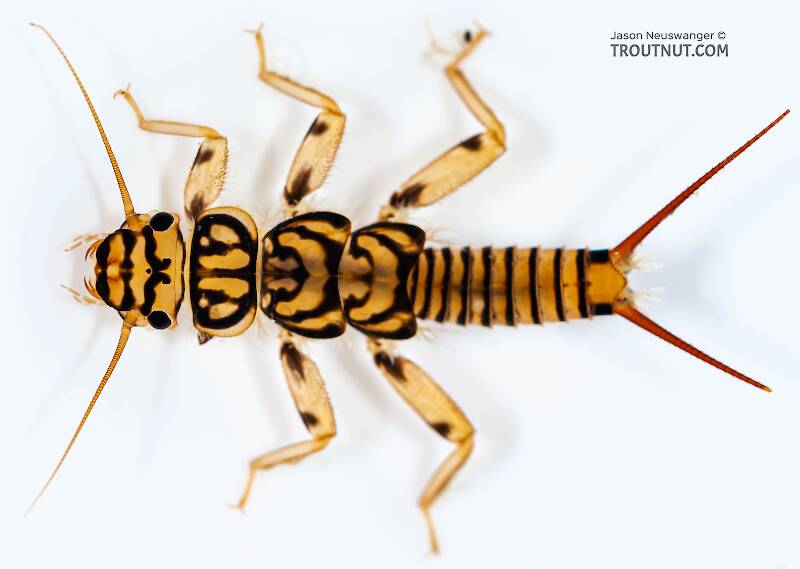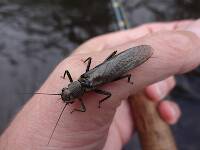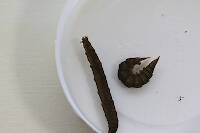
Blue-winged Olives
Baetis
Tiny Baetis mayflies are perhaps the most commonly encountered and imitated by anglers on all American trout streams due to their great abundance, widespread distribution, and trout-friendly emergence habits.
Featured on the forum

Some characteristics from the microscope images for the tentative species id: The postero-lateral projections are found only on segment 9, not segment 8. Based on the key in Jacobus et al. (2014), it appears to key to Neoleptophlebia adoptiva or Neoleptophlebia heteronea, same as this specimen with pretty different abdominal markings. However, distinguishing between those calls for comparing the lengths of the second and third segment of the labial palp, and this one (like the other one) only seems to have two segments. So I'm stuck on them both. It's likely that the fact that they're immature nymphs stymies identification in some important way.

Troutnut is a project started in 2003 by salmonid ecologist Jason "Troutnut" Neuswanger to help anglers and
fly tyers unabashedly embrace the entomological side of the sport. Learn more about Troutnut or
support the project for an enhanced experience here.
GONZO on Oct 4, 2006October 4th, 2006, 8:58 am EDT
The row of spinules across the back of the head in combination with the presence of anal gills indicates that Agnetina is the likely genus; and the dorsal pattern appears to be classic capitata.
Troutnut on Oct 4, 2006October 4th, 2006, 9:00 am EDT
Thanks. I've moved it to that species.
Jason Neuswanger, Ph.D.
Troutnut and salmonid ecologist
Troutnut and salmonid ecologist
MattyL on Jul 2, 2008July 2nd, 2008, 3:15 am EDT
Just to add to Gonzo's assessment of characteristics, A. capitata is identified most definitively by looking at the dark pigment on tergum 10 as well as the head pattern. With this species, the pigment band on tergum 10 is uninterrupted (though it narrows quite a bit). The head "M line" is nearly lateral, as apposed to A. flavescens, for example, which really looks like an M with posterolaterally directed arms.
-Matt
Jmd123 on Mar 23, 2011March 23rd, 2011, 6:36 am EDT
What a beautiful creature! Jason, did you collect this one? If so, was the leg missing when you collected it? Just curious.
Jonathon
Jonathon
No matter how big the one you just caught is, there's always a bigger one out there somewhere...
Troutnut on Mar 23, 2011March 23rd, 2011, 6:41 am EDT
Yes, I collected it. I don't go pulling legs off my bugs at random, so the leg must have been missing when I found it in my sample tub. However, I sample with a kick-net, which is kind of a rough process for the bugs, so it could have been lost during that. I've also had bugs lose limbs to predators in my bucket/tub, but that's unlikely for a stonefly this size.
Jason Neuswanger, Ph.D.
Troutnut and salmonid ecologist
Troutnut and salmonid ecologist
Jmd123 on Mar 23, 2011March 23rd, 2011, 8:58 am EDT
We handled our bugs pretty roughly during our last project (oil-polluted streams in north Toledo) and I am surprised that more of them didn't end up being damaged. The vast majority of them were perfectly intact, even after we had to subsample and thus give them another round of rough handling. Perhaps attacked by a crayfish or small fish? Or a fight with another stonefly nymph?? Crayfish will go after each other pretty good and tear off limbs.
Again, what a beautiful insect. It makes me glad that I went into entomology. Too many people miss the wonders of the natural world which is all around them, sometime in quite tiny form. A good microscope helps. Gotta take time to "smell the roses".
Jonathon
Again, what a beautiful insect. It makes me glad that I went into entomology. Too many people miss the wonders of the natural world which is all around them, sometime in quite tiny form. A good microscope helps. Gotta take time to "smell the roses".
Jonathon
No matter how big the one you just caught is, there's always a bigger one out there somewhere...
Quick Reply
Related Discussions
Topic
Replies
Last Reply
Re: I need your help to get some specimens of Caecidotea (Freshwater isopods).
In General Discussion by Leonardo
In General Discussion by Leonardo
4
Jun 1, 2016
by Crepuscular
by Crepuscular
9
Jun 19, 2013
by Brookyman
by Brookyman






